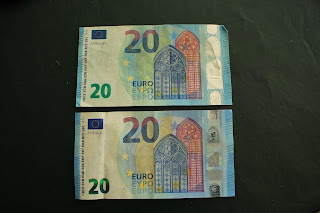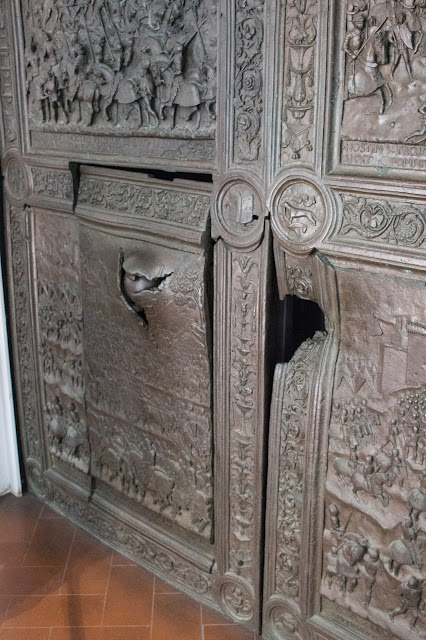Around 2,000 BC the Greeks began to settle there. Naples ranks near the top of the list of the worlds oldest continuously inhabited cities. Why is it so popular? Simple - pizza.
That and the big natural harbor.
Given that next door to Naples is Pompeii, Naples has some of the finest museums in the world (see earlier blog http://katfishkapers.blogspot.com/2015/01/never-trust-mountain-italy-part-2.html.). The museum/castle Castel Nuovo isn't one of them. That being said, it was still fun to visit.
Castel Nuovo was built in 1279 by Charles of Anjou. Most of what you see, however, is work done back in the 15th century - including the triumphal arch added in 1443 (the lighter stonework nestled between towers on the right above). The arch was commissioned by this guy:
 |
| Alfonso V of Aragon If it was me having my portrait done I believe I would have the artist paint me with 6-pack abs. |
"Alfonso held the classical Roman writers in reverence and set an example for future princes of Italy, who considered patronage of great art and architecture a way of making their permanent mark on the states they ruled."
He had the arch built so he would look cool when he rode into the city after having conquered it (after a 20 year slugfest).
Rumor has it that the arch was supposed to be a free-standing affair, but the land it was to be built on belonged to a captain in Alfie's army. The captain persuaded Alfie to build it into the castle.
 |
| The relief depicts Alfie riding into the city |
Italy is full of sculptures. After a while you can get jaded to them, however, building this arch was no trivial affair. It took five master sculptors and thirty-three assistants chiseling like madmen to make it.
 |
| OK this one isn't so good. Still, how many times to you get see a snake biting a stone woman? |
 |
| "Happy birthday ma! Look, I built you this bird house all by myself". |
Inside the castle you will find various halls and exhibits. This hall is locally famous (the Naples City Council met there until 2006).
In keeping with that gruesome story, in the room next door you can see skeletons resting through the glass floor:
 |
| The skeletons aren't the executed barons. At one point the castle was used as a convent. These are probably just executed nuns. |
The most famous exhibit at the castle is a cannonball. Not just any old cannonball - like they say in real estate "location, location, location".
If you look closely at the cannonball holes - they don't make sense. There are holes going both ways through the door. It's almost like the castle defenders were too afraid to open the door before firing (screw aiming, just blast through the door and hope you get lucky). The explanation takes a lot of the fun out of the speculation. The doors got all shot up in a sea battle, while in crates being transported by ship from France in 1495.
There are other artsy exhibits in halls:
 |
| Ferengi inspiration? |
 |
| If memory serves me correctly, this is Death of Joseph. |
 |
| Wings made by Ronco? |
 |
| "What the hell did he sit on? Don't tell him, don't tell him. This is hilarious" (Teofilo Patini, 1864) |
 |
| "Hey you creep, get outta here" The first selfie stick used for spying. (Raffaele Tancredi, "La Lettera") |
 |
| "Sorry, we don't allow Yelp reviewers to eat here". (Giuseppe Costa, "Posteggiatore o Musici"- restaurant singers, 1891 ) |
After touring the castle I had a lovely lunch at the above restaurant. When it came time to pay I thought I was going to end up spending the night in jail. Lunch was 11 euros. All I had on me (I never carry a wallet in Europe - pickpockets are everywhere) was a 20. Turns out the 20 was counterfeit. Thank God the people at the table next to me were from my ship.
 |
| Look normal to me (the one on top is fake) |
 |
| Now you can tell (bottom one has the correct clear panel with hologram) |
















































































































